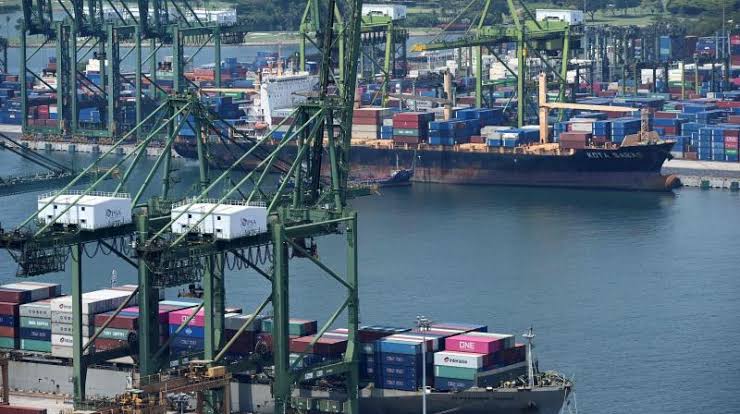EXPORTS: INDIA’S $400 BILLION MILESTONE

Article By
V P Nandakumar
MD & CEO Manappuram Finance Ltd
India’s merchandise exports grew by 43 per cent in 2021-22 to cross the milestone of $400 billion dollars. The record exports in FY 2021-22 represent a 33 per cent surge over the pre-pandemic levels of 2019-20.
If the year 2020 was defined by the pandemic and all the stresses occasioned by it, it may be said that 2021 was the year of economic recovery with pent-up demand and generous fiscal and monetary stimulus by governments and central banks around the world spurring economic activity. However, by the time we entered 2022, the picture had darkened somewhat with inflation emerging as a major threat to global growth. And then, the war in Ukraine (which started on 24 February) added to the gloom. Consequently, stock markets around the world have begun to surrender the extraordinary gains they registered in 2021. Here in India, there are signs that with inflation threatening to get out of hand, the RBI may be forced to follow in the footsteps of the US Federal Reserve and push through a series of hikes in interest rates. Already the first shot has been fired with an unexpected hike of 40 bps in interest rates announced on May 4, 2022. All the same, amid the increasing pessimism about our economic outlook, there are some positive trends as well that bode well for the future.
One such trend is related to India’s collections under the goods and services tax (GST). Recently, it was reported that GST collected in April 2022 (and pertaining to the economic activity in March) broke all records, having touched Rs.1.68 lakh crore. This is the 10th month in a row that the GST revenues have exceed ₹1 lakh crore and the April collection is about 20 per cent higher than Rs.1.40 lakh crore achieved in April 2021.
The other notable trend is related to India’s exports which is the subject of this article. On 23 March, Commerce Minister Mr. Piyush Goyal announced that India’s merchandise exports had crossed the $400 billion milestone for the first time ever in FY 2021 – 22. India’s goods exports (which excludes exports of services) grew by 43.2 per cent in 2021-22 to nearly $418 billion dollars, rising by over $125 billion compared to the figure recorded in FY 2020-21 which was affected by the pandemic. The record exports in FY 2021-22 represent a 33 per cent surge over the pre-pandemic levels of 2019-20.
The key export sectors to contribute to the extraordinary growth include petroleum products, engineering goods, gems and jewellery, chemicals, and pharmaceuticals. Engineering goods exports grew 46 per cent over the year at $111 billion, of which about $16 billion was shipped to the U.S. alone. Agricultural exports have crossed $50 billion during the year with significant growth in exports of rice, wheat, marine products, coffee, and dairy products. Other sectors reporting exceptional growth include petroleum products and drugs and pharmaceutical products. Bangladesh was the biggest importer of Indian chemicals, while China was the biggest buyer of gems and jewellery. Indian exports were earlier dominated by the neighbouring and ASEAN nations, but this year exports recorded a significant jump to developed countries like the US, Netherlands, UK etc.
Significantly, the composition of our exports is shifting towards higher value-added products. For long a primary goods exporter, India’s export of commodities and raw materials saw a decline in 2021-22 on account of fall in iron ore and oil meal exports.
FACTORS DRIVING THE GROWTH
Pent up demand: Demand for goods had fallen as the Covid pandemic forced people around the world to remain indoors under lockdown. As the situation became normal, people went out of their way to make up for the time lost under lockdowns and consequently there was a pent-up demand for goods and services that became visible everywhere.
Improved competitiveness: India’s export surge was helped by the increase in domestic manufacturing capacity and its improved competitiveness. For example, India’s exports of mobile phones have now crossed USD 6 billion; till a few years ago, there were no exports under this category. The Production Linked Incentive (PLI) scheme first launched in March 2020 has supported growth in exports, particularly in mobile phones, electronics, drugs and pharma sectors.
The PLI scheme also gave a fillip to the local assembly of smartphones and boosted mobile phone exports from the country. A total of 14 companies have been shortlisted for inclusion under the smartphone PLI scheme, which was announced in April 2020. The government also gave special attention to defence exports. As a result, the value of defence exports has risen to Rs 11,607 crore in FY2022 (till March 21, 2022) from Rs 1,941 crore in the FY2015.
Improved infrastructure: India has been continuously improving its logistics and connectivity infrastructure which helps our quest to become a global manufacturing hub. It is essential to reduce logistics costs in order to boost exports at a time when global firms are increasingly moving their manufacturing facilities out of China to de-risk global supply chains.
The Covid-19 outbreak in the first quarter of FY 2020-21 led to rising demand for staple foods which paved the way for higher agriculture exports. Thanks to the special efforts made to overcome the pandemic-induced bottlenecks, India was able to rise to the occasion and emerge as a reliable supplier of food. Our agricultural exports have grown by nearly 20 per cent in FY 2021-22 to $ 50.21 billion. Remarkably, this growth was achieved on top of the growth of 18 per cent achieved in FY 2020-21 when we recorded $41.87 billion in agricultural exports. In fact, in the current scenario following the outbreak of war in Ukraine, India is being looked up to for supplies of wheat and other food grains.
The two mega initiatives of the Indian government, the National Monetisation Pipeline (which seeks to augment infrastructure through private investment) and the PM Gati Shakti plan (a national master plan for multimodal connectivity) are expected to further boost India’s agricultural and processed food products exports and sustain it in the years to come.
Efforts to reduced dependence on China: With Covid-19 disrupting global supply chains, many multinational companies have shifted parts of their production platforms away from China to India and other Asian countries. The trend had begun prior to the pandemic. With continuing tensions over trade issues between the US and China (recall that it all began under the Trump presidency), US importers have reached out to India for import of relatively lower value items like sports goods, toys, stationery, cables and electronics parts because punitive tariffs on imports from China have made them expensive. US businesses are therefore looking to replace Chinese exports with Indian products in at least seven product lines including vulcanised rubber, footwear, and kitchen accessories. India exported $1.5 billion worth of these items to the US in FY 2018-19.
Inflation, an artificial boost to exports: The global recovery from the pandemic has seen a sudden surge in the demand for goods and services which in turn has led to the prices of energy, commodities including metals, and food rising sharply. One of the factors contributing to India’s export performance is that higher prices have artificially boosted the value of our exports. India’s export of petroleum products (which accounts for 15 per cent of our overall exports) grew by 152 per cent thanks largely to the high crude oil prices. The UAE was the top destination for petroleum product export in FY22. The year saw continuous increases in the price of crude oil as demand increased as the global economic recovery took hold, and now even more so after the war in Ukraine and sanctions on Russia took hold. Besides, India has also done well in the exports of iron and steel, copper, other metals, and cereals.
Government’s fillip to domestic manufacturing: The timely initiatives of the government have also played a key part in promoting Indian exports. To promote Indian products in the global market, the government implemented a series of measures to promote exports of goods and services. The introduction of Refund of Duties and Taxes on Exported Products (RoDTEP) and the Rebate of State and Central Levies and Taxes (RoSCTL) Schemes have addressed some of the grievances of exporters. The launch of the Common Digital Platform for Certificate of Origin facilitates exports by increasing the utilisation of free trade agreements (FTA) by exporters.
The $400 billion export landmark was achieved through a bottom-up approach where the trade potential for different countries was assessed based on past trends. Exports were examined by product and state and 200 countries and territories were targeted. Attention was given to lost markets, low hanging fruits (where India has competitive advantage), and in faster resolution of the issues faced by exporters. Active engagement with different export promotion councils, industry associations and other stakeholders helped in reaching this milestone.
YES, IMPORTS HAVE ALSO SURGED
While talking about our record exports, it must be mentioned that India’s trade deficit widened to $192 billion in FY22 as imports hit a record high of $610 billion. This was mainly because the value of petroleum imports nearly doubled as compared to the year before. Recall that global petroleum prices had fallen sharply in the aftermath of Covid-19 which had artificially suppressed the value of petroleum imports in FY 2020-21. The sharp 94 per cent jump in the value of petroleum imports was due to the rise in global crude oil prices during the year. Indeed, petroleum accounted for 26 per cent of our total imports in FY 2021-22. The below table shows how imports have also surged during last two fiscal years. However, when we consider the pre-pandemic FY2019-20 as the base (being free of pandemic related distortions), it will be seen that growth in exports have outpaced growth in imports.
India has now set a target of USD 500 billion exports for FY 2022-23 and hopes to touch USD 1 trillion exports by 2027. The centre of gravity of international trade has shifted away from Europe and the US to Asia. Multilateral trade agreements are losing ground to bilateral agreements and India is presently in the process of entering into FTAs (or free trade agreements) with six countries. We have signed an interim trade pact with Australia and a Comprehensive Economic Partnership Agreement (CEPA) with the UAE. Trade talks with the UK are going on and an agreement is expected shortly. The list of other countries and regional blocs negotiating trade deals with India includes Russia, Canada, the GCC, and the Southern African Customs Union. The Ukraine war has badly affected the world economy and created a commodity squeeze in Europe, which countries like India can fill in. For instance, an outcome of the sanctions on Russia is the likelihood of a steel shortage in Europe that countries like India are well positioned to make good.
While the prospects for exports look good as of now, there are downside risks too. The global tightening of liquidity, continued volatility in global commodity prices, high freight costs, the possibility of new variants of COVID-19 causing a resurgence etc. may pose a challenge for India’s ambitious export targets.
Pic Courtesy: google/ images are subject to copyright








